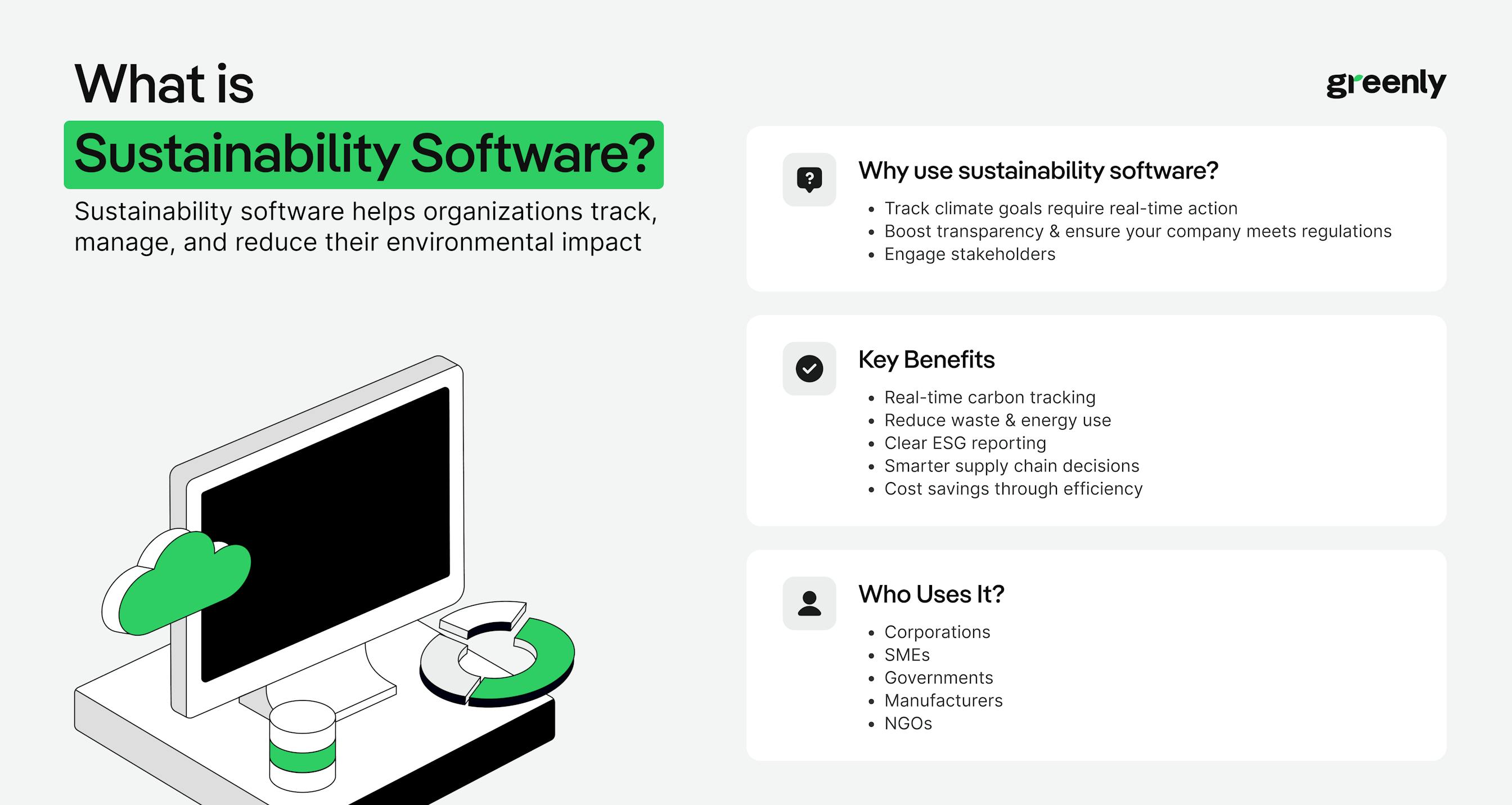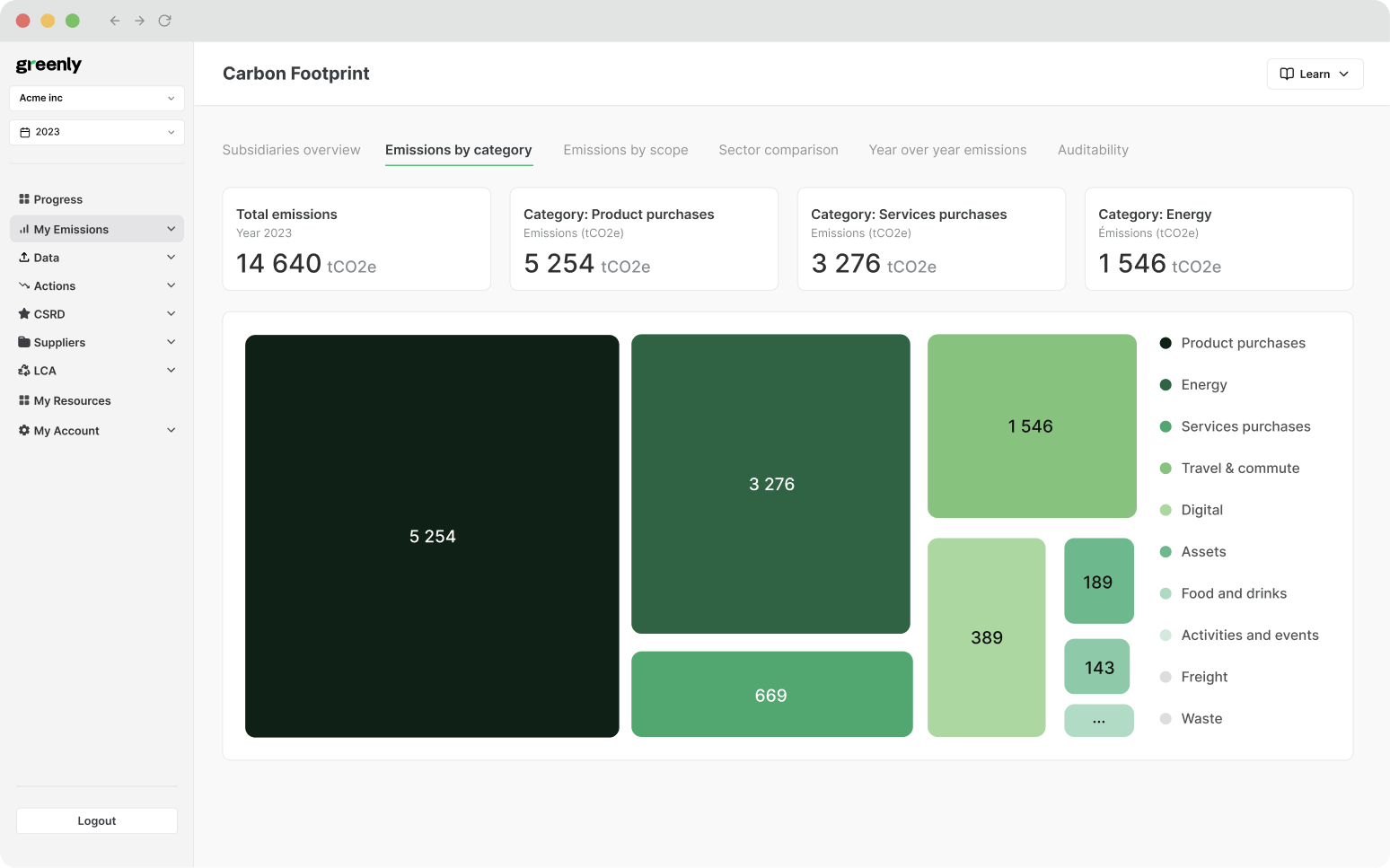
What are the 3 Pillars of Corporate Sustainability?
In this article, we'll explore what the 3 pillars of corporate responsibility are, why they're important, and how businesses can turn them into practical action.
ESG / CSR
Industries



Explanation of environmental software and its importance
Key components of environmental software
The most crucial elements of environmental software & our top picks
Businesses around the world, regardless of size or sector, are beginning to take an interest in their environmental footprint by using environmental software to adhere to customer and stakeholder expectations – in addition to complying with new environmental regulations.
Environmental software can help companies to improve their data tracking and sustainability reporting, both of which are becoming essential in the midst of climate change.
In this article, we’ll explain what environmental software is, the benefits, examples, and 5 key components to look for in environmental software.
Environmental software refers to digital tools or platforms specifically designed to monitor and manage a company’s use of various resources with the ultimate goal being to help them reduce their overall environmental impact.
Therefore, environmental software can help companies to get a better understanding of their current electricity, gas, or water usage – which can help them to mitigate an excessive environmental footprint.
The most effective environmental software should allow users to get a better understanding of their past and current business practices to help curate a more sustainable and efficient business model for the future.
Here are some crucial elements your company should look out for when seeking environmental software:
All good environmental software starts with tracking your data, which can often include collecting information from your suppliers.
The most helpful environmental software should help reduce your company’s busywork by helping to draft sustainability reports to demonstrate compliance and success in achieving your various environmental targets.
Environmental software should help companies both measure and analyze their greenhouse gas emissions to develop more effective reduction plans.
Good environmental software integrates seamlessly with other systems, automating data collection and ensuring continuous accuracy across departments.
Environmental software must help businesses to identify and mitigate potential environmental risks before they become costly issues.
While this is not essential, providing information on carbon accounting such as on a platform like Greenly can help companies excel in meeting their reduction targets.
As there are new environmental regulations being passed frequently, environmental software should provide guidance on local, national, and international compliance standards.
Modern solutions allow cross-departmental collaboration and communication with stakeholders to improve transparency and sustainability performance.
Ultimately, environmental software is used for companies looking to better manage and reduce their current environmental impact – and it is becoming more compulsory than optional as increasing transparency with stakeholders and complying with environmental regulations are imperative to business success.

Environmental software is important because it allows companies to reduce their environmental impact and effectively communicate their current progress.
Without the assistance of environmental software, many companies wouldn’t know where to start on their climate journey – the same way a student may not know where to begin when preparing for an exam without a study guide.
Here are some of the reasons why environmental software has helped to benefit companies and why it’s increasingly essential:
Since environmental software helps companies to track and improve their current emissions, water usage, waste production, energy consumption – a reduced environmental footprint is often the result of using effective environmental software.
As new regulatory requirements continue to be released, many companies are finding themselves struggling to comply before the deadline – but environmental software can help companies manage these legal expectations and avoid the risk of potential financial consequences or damage to brand reputation.
Environmental software doesn’t only help to ensure compliance, but can ultimately help businesses to cut back on operational costs as a result of encouraging energy efficiency to reduce water, energy, and resource usage.
From the CSRD, to the NFRD, the SEC Climate Disclosure Rule, and more – automated data tracking helps companies ensure transparency, avoid greenwashing, and meet emission reduction targets.
In the midst of climate change, almost anything could impact your business – such as natural disasters or disruptions to your supply chain. Environmental software helps companies prepare for these events and ensure business continuity.
Consumers increasingly value sustainability. Committing to environmental software can build trust with customers, investors, and business partners, ultimately boosting brand reputation and loyalty.
Many types of environmental software on the market, including Greenly, offer assistance in carbon accounting to help companies track and reduce their emissions while maintaining alignment with corporate goals.
Environmental software helps businesses better understand and communicate their Environmental, Social, and Governance (ESG) goals, supporting transparency and improvement in sustainability reporting.
As a whole, environmental software can help companies make improved decisions regarding their current environmental impact – which can help to cultivate a more sustainable business world while also boosting their own chances for a more successful company.
The table below will reveal the various benefits associated with companies that use environmental software:
| Benefit | Description |
|---|---|
| Improved Environmental Reporting | Environmental software automates data collection and provides detailed reports on emissions, waste, and water usage, making regulatory reporting more efficient and accurate. |
| Enhanced Compliance | Helps companies stay compliant with environmental laws and regulations by tracking compliance metrics and deadlines, reducing the risk of fines and sanctions. |
| Resource Efficiency | Provides insights into energy and resource use, enabling companies to reduce waste, save costs, and improve overall resource management. |
| Carbon Footprint Reduction | Enables tracking of carbon emissions across operations, facilitating targeted strategies to reduce greenhouse gas emissions. |
| Risk Management | Environmental software identifies potential environmental risks and provides tools for proactive mitigation, helping businesses avoid costly environmental liabilities. |
| Data-Driven Decision Making | Enables the use of real-time environmental data for informed decision-making, supporting sustainability goals and strategic planning. |
| Stakeholder Engagement | Enhances transparency and accountability, allowing companies to communicate sustainability efforts to investors, clients, and the public effectively. |
| Enhanced ESG Performance | Supports environmental, social, and governance (ESG) initiatives by providing tools to track and report on environmental metrics aligned with ESG goals. |

Examples of environmental software include Greenly, IBM ESG and Environmental Suite, and Sphera.
At Greenly, we’re known for our intuitive platform and exceptional service from our climate experts in addition to our specialized software to help companies effectively track and reduce their emissions.
Check out our demo video below to see just how easy and intuitive environmental software can be:
The interactive flip cards (move cursor over card to flip) will reveal a few more examples of environmental software:
Aimed towards helping companies track environmental data to streamline regulatory reporting, this software helps avoid legal fines due to noncompliance with current environmental regulations.
This software uses a geographic information system (GIS) to help companies with environmental mapping and spatial analysis for sustainability planning.
A well-known environmental software offering in-depth analysis for ESG reporting, helping companies boost CSR initiatives.
Provides software for managing Environmental, Health, and Safety (EHS) within organizations, helping ensure operations run smoothly while minimizing environmental harm.



Environmental software should offer users precise data analysis, assistance for various sustainability reporting and compliance management, risk assessment, and guide companies towards potential sustainable solutions to reduce their current environmental impact.
Effective environmental software will take both your past, present, and future environmental impact into account – as sufficient environmental software should provide companies with ample information to improve their current environmental impact today and onward.
Here’s a breakdown of the 5 things that all environmental software should have:
The hallmark of any tool or platform designed to help you or your company improve should be focused on its data collection and analysis methods.
Therefore, data collection and analysis is imperative for any environmental software company.
One of the main reasons companies will seek the use of environmental software is to ensure compliance with current and future environmental regulations, acting as a personal assistant to help companies remain cognizant of all the current climate requirements applicable to their business.
Excellent environmental software should always offer assistance for drafting reports and complying with relative environmental regulations.
These days, there are are multiple risks associated with climate change – many of which a company couldn’t think of without the help of environmental software.
Since the main goal of environmental software is to understand a company’s past and current actions to rectify them for the future, it is crucial to choose environmental software that can determine the potential risks to your business in the midst of global warming.
The summary cards below will reveal how environmental software can help with risk assessment:
In addition to preparing for future circumstances, good environmental software should track a company’s current usage of resources such as water and energy consumption.
The best assistants, tools, or friends don’t only focus on the problem at hand, but want to help you achieve greater success as you head towards the future – and a proficient environmental software should aim to do the same.
Good environmental software will seek to guide companies towards personalized and effective solutions to reduce their environmental impact moving forward, such as by providing a network of carbon offsetting projects, ideas for more ethical sourcing, or ways to help decarbonize your supply chain.
Ultimately, the best environmental software will provide your company with the tools to understand the impact of your past actions and how to improve them moving forward.

If reading this article on environmental software has made you interested in reducing your carbon emissions to further fight against climate change – Greenly can help you!
Choosing the right environmental software to help your company achieve its climate goals can be challenging, but don’t worry – Greenly is here to help. Click here to schedule a demo to see how Greenly can help you find ways to improve energy efficiency and decrease the dependency on fossil fuels in your own company.
Greenly can help you make an environmental change for the better, starting with a carbon footprint assessment to know how much carbon emissions your company produces.
Click here to learn more about Greenly and how we can help you reduce your carbon footprint.
